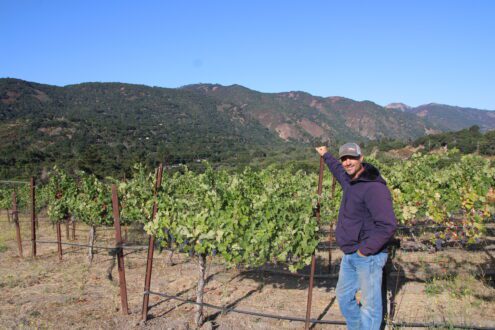
Apr 21, 2024Carmel Valley winegrapes: Parsonage Village Vineyard
Thinning, wildlife control aid Parsonage Village Vineyard
Aggressive pruning is part of staying on top of things at Carmel Valley’s Parsonage Village Vineyard that grows grapes by battling disease, weeds, wildlife damage and other obstacles.
In 1998, Parsonage founders Bill and Mary Parsons, and daughters Ali, Rachael and Brooke, planted seven acres. Though the couple graduated from the same Southern California high school at different times, they didn’t meet until later. They married three months after a 1969 blind date when Bill was an undercover agent handler/case officer for U.S. Army Intelligence in Italy after serving in U.S. Special Forces in Vietnam. The name Parsonage comes from the home Bill and Mary live in, which is in the center of the vineyard.
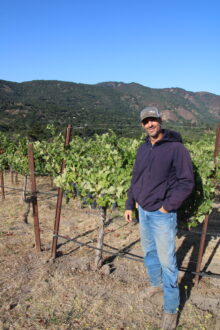

A critical part of any growing operation, water is even more important for Carmel Valley winegrape growers who some years may receive less than 10 inches of rain. With vineyards 14 miles from the Pacific Ocean, Parsonage is stressed by a lack of water along with increasingly strict state regulations.
The Carmel Valley averages 14- 15 inches of rainfall, with lower precipitation years reducing winery tonnage. In 2006, Parsonage produced 25 tons of wine compared to 2022, when it didn’t yield one ton. In 2023, the Monterey County operation recovered to eight tons.
“This is a great vineyard for everything you could ask for,” said Frank Melicia, winemaker and vineyard manager. “It has great weather, great soil conditions and a wonderful location. It just needs water.”
Unlike other Central Coast winegrape growers that suffered extensive powdery mildew damage, Parsonage escaped injury. A grower should remain on top of spray programs, Melicia said. Parsonage sprays every 12 to 14 days.
Aggressive pruning
Parsonage weed whacks and hoes like organic vineyards. As many growers are anti-spraying, Melicia said the farm tries to engage in as little spraying as possible, though the vineyard isn’t certified organic.
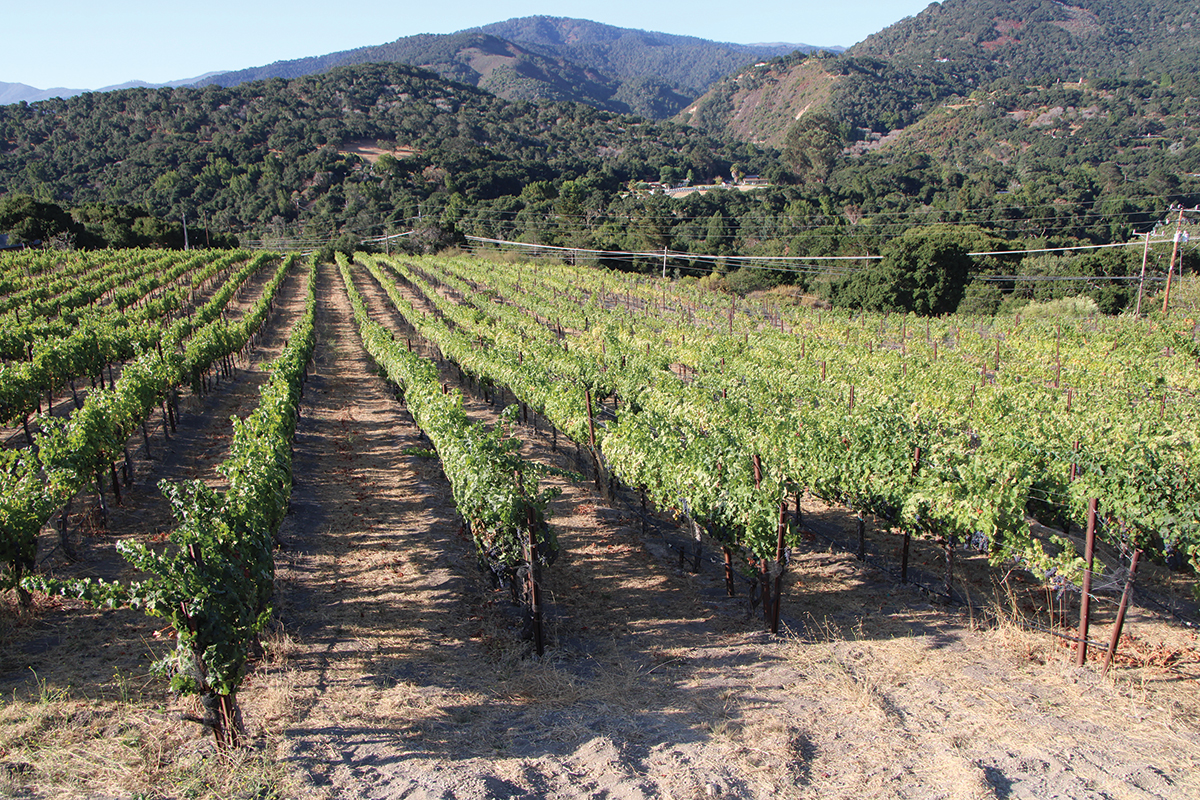

In addition to spraying, Parsonage thins clusters and leaf pulls. Pressed by water stress, Parsonage employs what Melicia characterizes as extreme leaf removal, removing leaves through the fruit zone. More common today, it was a practice in the past that others might not have engaged in unless they were encountering large powdery mildew problems.
“It’s cutting back so it’s fewer canes and less fruit to try to throw, so the vine doesn’t work as hard,” Melicia said. “It’s hard to farm without rain, but there are little things I try, but, for the most part, it’s negligible.”
Some growers didn’t aggressively thin last season, which produced massive fruit. “There was a ton of fruit,” he said. “If you didn’t also go through and thin and leaf pull all these things, you had to be on top of thinning the clusters because it was just chaos inside the canopy. When people thinned the leaves through the fruit zone, at that point, it was generally too late. We’re pretty lucky here with how much leaf pulling we can do.” Because of Eutypa dieback, or dead arm,
Melicia in 2002 hand pruned the entire vineyard, cutting vines until he hit favorable wood. Parsonage also picks higher sugar fruit late in the season, near Thanksgiving, something others weren’t doing as much in the past, Melicia said. While leaf hoppers and mealy bugs are present, Parsonage has largely avoided insect problems.
A foot of chalk rock soil on top of limestone and decomposed granite produces great wine but makes for difficult vine growth. Plus, growing winegrapes on steep hills can be difficult.
Air challenge
Birds present challenges. Nets throughout the year have proven effective. Workers are hired to lift and close the nets. Many types of birds threaten grapes, with European starlings and crows being big pests.
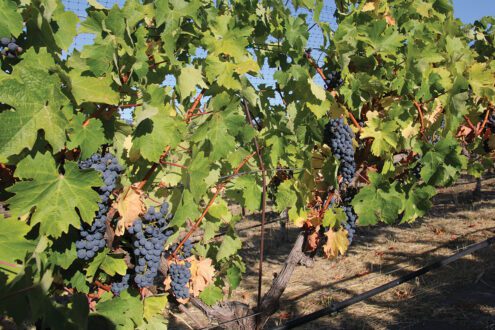

Yellow jackets and wasps can also be problematic. Because of their small size, wasps enter the nets and eat entire clusters. Parsonage uses store-bought topping traps. Bird netting is draped over the entirety of the vine at veraison, when grapes mature color to help alleviate damage. The nets only go over the vines then because the birds wait until grapes produce enough sugar, Melicia said.
Other wildlife, including coyotes, foxes, gophers and turkeys, can cause damage. Macabee snap traps work but are painstakingly slow, he said. Parsonage used to employ aluminum phosphate. California’s strict rules, however, made it not worth the effort, Melicia said.
Gophers can be troublesome, Melicia said. Last year, he thought he had a good handle on them, but suddenly, an explosion of new gopher holes appeared. Temperatures consistently ranging from 75º F to 82º F degrees reduce potential for losing fruit to sunburn.
“We’re able to open up the canopy for airflow, which alleviates a lot of that mildew pressure, but other places get crushed with sunburn,” Melicia said.
The Parsons were the first to plant Syrah, then considered a “peasant grape,” in Carmel Valley. The company also plants Cabernet Sauvignon, Merlot and Petit Verdot.
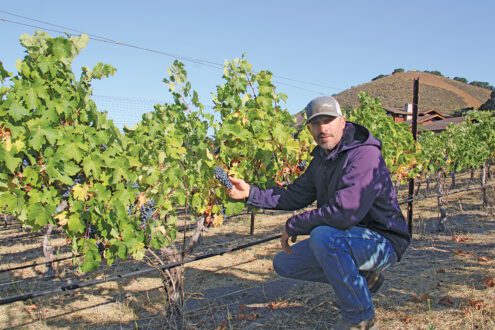

After marrying, Bill and Mary Parsons moved to New York where Bill graduated Columbia University. Arriving in Salinas, a promised TV news job disappeared. For a year, Bill wrote for a weekly newspaper before entering the garbage business, later becoming general manager of a waste management district and a partner in a group of waste disposal companies.
Wanting to pursue other dreams, the couple in 1997 sold their Carmel home and bought a 9-acre parcel in Carmel Valley to start a vineyard and boutique winery.
Melicia, Ali’s husband, has been the family-run Parsonage’s longtime winemaker and vineyard manager. Ali is partner, and Rachael is general manager, with Brooke and her husband, Marshall, helping.
Sometimes, Melicia can experience disappointments, like in 2016 and 2020 when man-made fires damaged vineyards and eliminated red wine production or when disease destroyed vineyards.
“You have to take the little successes and celebrate them,” he said. “I’m not driven by work. I’ve got a family and I’m more self-driven. “Whatever I do, I do the best of my ability,” Melicia said. “It’s not like I’m living and dying vineyard stuff. I have a real life and this is part of it.”
— Doug Ohlemeier, assistant editor














